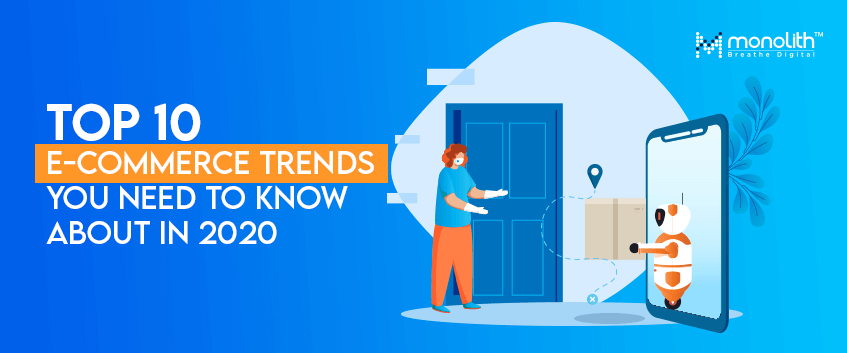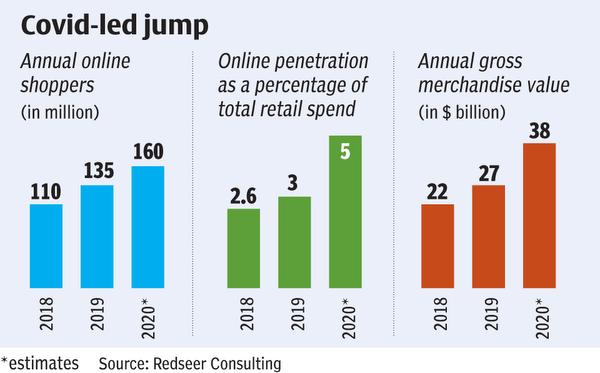How COVID-19 is Changing E-Commerce | Recent Trends & Updates in E-Commerce
December 28, 2020
Why e-commerce is the answer? With fluctuations in orders, customer behavior, and store closures, COVID-19 outbreak continues to change businesses everywhere and e-commerce, in particular, is seeing a significant impact. And, as per the early signs, this trend isn’t slowing down any time soon.
The growth projections estimate that by 2021, there may be as many as 2.14 billion digital buyers globally. Even though, global retail sales are expected to dip by 5.7% this year due to the pandemic, the e-commerce company Shopify, is expected to reach $4.2 trillion by the end of 2020 in global e-commerce sales.
Now that the Coronavirus pandemic has accelerated consumers’ shift toward e-commerce to a large extent, the growth of e-commerce companies like Amazon, Flipkart, Alibaba has skyrocketed across the board and have put e-commerce at the forefront of retail.
The Impact of Coronavirus
The ongoing Coronavirus pandemic is reshaping life as we knew it on a day-to-day basis; from the places we can travel to the way we spend our money and to the priorities we have. It’s impacting every part of our lives.
The E-commerce platforms have witnessed an unprecedented global traffic increase since the emergence of the pandemic. According to the analysis from Nosto, at the height of the lockdown; the daily global e-commerce sales have undergone a massive spike of 66%.
The impact of COVID in e-commerce is far and wide with a ripple effect on everything from small retail business to global juggernauts like Amazon and beyond.
How COVID- 19 helped Online Retail Companies?
“…witnessed a huge surge of 24.3% as Amazon becomes consumer’s go-to source…”
Major online retail companies like Amazon, Flipkart, Walmart, and Alibaba have benefited from the rapid transformation into e-commerce during the crisis.
- As consumers rely more heavily on e-commerce, especially the reliance on Amazon for a wider variety of everyday goods, Amazon’s global e-commerce sales are expected to grow $416.48 billion in 2020 according to the latest estimates from Business Insider.
- The report from Business Insider also suggests that when compared to the 9.5% Q1 2019 year-over-year growth in global first-party sales, Q1 2020 has witnessed a huge surge of 24.3% and another massive surge of 40% year-on-year growth in Q2 2020.
- It should be also noted that according to the financial data firm Facteus, consumer spending on Amazon between the months of May and July was up 60% from the same time frame last year as Amazon becomes consumer’s go-to source for products traditionally purchased at retail stores.
- By taking proactive decisions early, Verdo has scored a huge audience and repeat customers during the lockdown period. Verdo is an example of great initiatives and success as their figures went up by 192% during the crisis, with increased demands and sales.

Emerging E-Commerce Trends
The current crisis also paved the way for the emergence of new independent faces that have created their own niche spaces in the e-commerce circle.
The recent research from Bazaarvoice shows that 88% of global consumers are planning or showing signs to stick with the newly emerged brands or the ones they’ve found useful during the lockdown, rather than return to those they were using during the pre-pandemic period. Retailers are also fiercely beginning to adapt to newer technology to tackle the challenges presented by the Covid-19 era.
1. Changes in Buying Patterns
India‘s leading e-commerce focused SaaS platform, Unicommerce, recently released an impact report on the e-commerce industry in the post-COVID world that extensively covers key trends, growth, and performance analysis.
- One of the key highlights of the report states that consumer buying patterns have changed drastically with categories like health, pharma, and agriculture seeing exponential growth. The report also states that there is a huge rise in number of first-time online shoppers.
- Compared to the 9% in online revenue this time of last year, the automotive industry has seen a 42% increase in online revenue since March.
- On the other hand, the apparel/fashion industry has been on a downward trend, and the industry as a whole is expected to face a huge 27-30% drop in global revenue as a result. As the 4th Quarter of 2020 is in progress, the Indian fashion market is being leveled, pushing both heavyweights and startup ventures into the ground.
2. Contactless Payment
Although the concept as well as the practice of contactless retail has been around for time immemorial, it took 2020 to translate the “Contactless” idea into our collective vocabulary and part of the retail culture.
- As we all know, cash payments have become a thing of the past today. Due to the pandemic and cash being considered as a potential carrier of the virus, various types of e-commerce and contactless payments gained traction all across the globe.
- According to the reports of GlobalData, a leading data and analytics company, the trend will continue even after the pandemic situation is over, thus transforming the global payment ecosystem.
- Visa reported that more than half of consumers have changed the way they pay and are ready to switch to businesses that offer contactless payment options.
- Contactless payments have readily transformed into a go-to alternative to carrying out electronic funds transfer and the wide acceptance of popular mobile wallets such as Google Pay, Samsung Pay, and PhonePe which happens to support both QR codes and NFC payments have witnessed a strong boost during the pandemic.
The implementation of biometrics-based or biometrics-secured payments that effectively make use of the facial and touch recognition functions are also not so far away now.
3. Virtual Queuing
Another practice that’s increasingly found a commonplace in retail business and e-commerce in general as a means for crowd management is virtual queuing technology.
Customers/Shoppers can scan a QR code, or send a text message to a given particular mobile number, to either join a virtual queue or book a fixed timeslot for getting into the shop, which saves them time and also fewer chances for the virus transmission.
4. Facebook Shop
“More than 180 million businesses use Facebook’s ecosystem to connect to consumers…..”
Online shopping has rapidly accelerated as 85% of people worldwide are now shopping online which also marked opportunities for new emerging companies and existing companies to jump in.
Facebook is one of the most popular and hottest online spots where people hang out the majority of their time and studies show that Facebook users spend an average of 40+ minutes per day on the social network behemoth.

As part of the broader push to capitalize on the e-commerce boom and to keep up with the competition, Facebook launched a dedicated shopping section. It allows users to indulge in retail therapy which happened to be a turning point event in 2020 e-commerce market.
- Facebook launched Shops in May, a sell-side platform that practically enables Facebook and Instagram pages into online stores, with all usual features like product listings and checkout ability.
- Facebook then in July started testing a Shop tab for Instagram to create a dedicated section for consumers to browse products and services on the platform.
- By August, Facebook started testing a similar Shop tab for Facebook.
- With a variety of newly launched features like Live Shopping and Commerce Manager to connect your business to shops, and to create a foundation for a robust, end-to-end, peer-to-peer online shopping platform, Facebook is finally making a big wave into the e-commerce industry.
More than 180 million businesses use Facebook’s ecosystem to connect to consumers and now finally Facebook has created a formidable foundation to build a gigantic e-commerce marketplace. Also, to provide support and guidance to operate online, Facebook has partnered with E-commerce deities like Shopify, BigCommerce, WooCommerce, ChannelAdvisor, CedCommerce, Cafe24, Tiendanube, and Feedonomics.
5. Artificial Intelligence and Technologies
More and more people are relying on the internet for basic shopping needs and studies show that consumers are more than happy to do shopping over the Internet than the regular old way.
If you think Artificial intelligence (AI) only goes as far as chat bots, you are wrong. AI can significantly improve the user experience, customer satisfaction, and can also facilitate payment management, virtual business and detect potential fraud, thus have the potential to create the greatest impact on e-commerce in the coming years.
The use of AI is still a much-untapped e-commerce front.
- The use of AI can be applied to understand individual customer preferences to bring business efficiency improvements and it also has enormous potential in enhancing the user experience in e-commerce platforms with features like fraud detection, image categorization, price optimization, customer segmentation, personalized product recommendation, content personalization, virtual assistants, and improved search capabilities.
- The biggest benefit of AI in the Post-COVID world is its ability to forecast future demand and sales by analyzing the web site’s consumption patterns and improve inventory management, which will eventually turn into a staple for the e-commerce marketplace.
6. Chatbots
Now, companies will have to work on their core strategies of e-commerce to identify customer’s needs and to establish good lasting communication with them. That’s where chatbots have a role to play.
- Studies show that about 82% of people demand an ‘immediate’ response/reply to their questions while interacting with a brand online and the Post-COVID world can benefit with chatbots.
- Live chat and chatbots can establish an instant connection and smooth productive conversations with the customers by answering questions promptly and ensuring a better customer experience through the services.
7. Healthcare E-Commerce
COVID-19 has resulted drastic financial harm to many businesses around the world including apparel companies, airlines, rental companies, and restaurants, and brought many businesses to the brink of collapse. But it also saw the rise and breaking point for many e-commerce companies that were not doing economically well in the past few years particularly Healthcare and Beauty sector.
- According to new researches and figures, the majority of global sales in the health and beauty sector are forecast to move online because of the increased demand.
- It is expected that the online share of sales in the health and beauty sector is going to witness a huge 16.5% growth globally by the end of 2020.
- The healthcare industry and beauty sector will see the second-fastest e-commerce growth rate after the Household products.
- The online shopping giant Alibaba with a whopping $43.2bn in online sales is expected to achieve the greatest share in health and beauty online sales in 2020. Amazon closely followed by Pinduoduo, with sales growing to $28.8bn, and $16.8bn by the end of 2020 is expected to be ranked in the second and third positions.
8. Voice Search
As it is a much easier, faster, and safer way of interacting, voice assistants are taking off among consumers and has transformed into the most preferred way to interact with a brand. We’ve experienced a technological breakthrough and a new effective strategy in digital marketing with the introduction of voice assistants such as Amazon’s Alexa, Google Assistant, and Siri.

- Voice-based shopping is expected to jump to $40 billion in 2022.
- Recently, Google has increased its word recognition accuracy rate to over 90%, which is a 10% jump from what it was previously capable of.
- About 55% of teenagers are estimated using voice searches on a daily basis.
- Voice-based shopping is projected to increase by $40 billion in 2022.
- According to Forbes, by the end of 2020, 30% of all website sessions will be handled by voice searches.
- Voice search is also driving changes in SEO practices as Voice SEO has became a hot topic in the past few years.
9. Headless Commerce
Headless commerce architecture is built for the IoT (Internet of Things) age and provides a high degree of customization & flexibility for developers.
- Traditional e-commerce solutions sometimes forced developers to sacrifice flexibility, speed, and control when building e-commerce projects where headless commerce redefined how websites are designed, built, and maintained.
- By removing the predefined back-end logic from front-end presentation, headless commerce enables front-end developers with endless possibilities for customization that will help to propel your content anywhere and everywhere.
- Amazon is a perfect example for effective implementation of headless commerce and the latest study by Salmon reported that 60% of consumers prefer Amazon Prime-like services.
As e-commerce is going through a radical transformation, 2020 may see increased adoption of headless commerce.
10. PWA
As more and more consumers demand a collective, omnichannel-like experience and things like site speed and functionality are paramount to today’s e-commerce success, the use of PWAs or Progressive Web Apps in e-commerce is expected to see a rise in the coming years.
- The implementation of PWA technology is aimed to ensure optimal usability, more comfortable, and streamlined experience for users on any mobile devices without downloading an app at all.
- According to Gartner Research, PWAs will replace 50 percent of all consumer- facing native apps by the end of 2020.
- While websites like Aliexpress has pioneered the use of PWAs in e-commerce, social media websites like Twitter and Gmail have been using PWA technology to great success for a while now.
- Microsoft and Samsung have joined Google in an effort to actively support, and promote PWAs in all their platform\devices.
The pandemic has had an unfathomable effect on the economy, sales, and stocks that will linger on for years to come. E-commerce businesses have burgeoned to entirely astronomical heights, while several business sectors in the retail industry have brutally collapsed. E-commerce companies like Amazon and Flipkart with the right strategically played moves have translated to great results were lack of preparation and ideas has resulted in bankruptcy for many other companies.
While Healthcare, Beauty, Cosmetics, and Automotives companies are witnessing a new highpoint every day, many apparel stores, the travel industry, the hotel sectors, and restaurants are bidding the business world adieu.
The business environment, especially in the E-commerce sector is undergoing significant changes, writing new rules in the book for future business and only time will tell what or when the next boom is going to happen.
Also, refer blogs about Why Digital Marketing, and Email marketing strategies.
